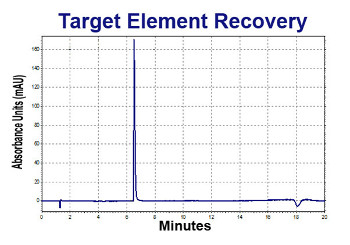Sep 12 2013
In the first formal laboratory test of its process separation technology, TerraSep LLC has confirmed that its multi-column Preparative/Process scale Centrifugal Liquid Chromatograph (P-CLC) achieved a level of separation efficiency that is orders of magnitude higher than current industry standard processes.
During a 30-minute test conducted July 26, 2013, the TerraSep P-CLC separated and captured greater than 90% of a target dye substance from a commercial preparation of 85% Indigo Carmine dye. The test results (below, from an analytical HPLC data display) showed the recovered substance as a single blue peak without other contaminating peaks.

Earlier tests of TerraSep's companion Analytical scale Centrifugal Liquid Chromatograph (A-CLC) system demonstrated a separation efficiency 200x that of standard HPLC systems.
"This demonstration of the TerraSep system's efficiency in identifying and separating a target substance confirms it is a platform technology capable of replacing liquid chromatography (HPLC), currently the third most widely used scientific instrument for many laboratory and process applications worldwide," said TerraSep CEO Jim Meador. Initial market segments targeted for TerraSep system use include fine chemicals purification, petrochemicals, medical products and others according to Meador.
"The most significant finding of this test is that the data's peak amplitude in relation to its narrow width demonstrates the TerraSep system achieves and exceeds the level of selection specificity required in any industrial processing, quality assurance or analytical application," said Robert R. Kerr, PhD, TerraSep Founder and Vice President of Research and Development.
"The system's Improved separation specificity is the product of utilizing smaller stationary phase particles, which is made possible by our use of centrifugal force rather than high pressure to drive samples through test media," Kerr said. "In comparison, pressure-driven HPLC systems have reached a practical limit in decreasing particle size at 1.7 microns for analytical applications, and 10 microns for preparative and process scale systems."
The P-CLC system’s use of centrifugal force allows it to employ smaller-size stationary phase particles – 1.7 microns and smaller on a Preparative/Process scale -- to create significant performance advantages compared with Preparative/Process liquid chromatography, according to Kerr, including:
- Ability to separate previous inseparable mixtures
- Ability to reduce labor costs
- Scalability
Liquid Chromatography
Liquid chromatography is the world's third most widely utilized analytical technique, used to separate ions or molecules in a solution for purposes of purification, identification of trace amounts, or as part of a manufacturing process. Analytical High Performance Liquid Chromatography (HPLC) systems, equipment, and consumables exceeded $5 billion in annual spending in 2008 and are used in the pharmaceutical, life science, food products, biotech, fine chemical, pesticide, cosmetics, power generation and environmental testing industries. Preparative/Process scale Liquid Chromatography – both low and high pressure – is an even larger market.
The Company
TerraSep LLC, with offices in Sunnyvale, California and Houston, Texas, has four issued U.S. patents on its centrifugal liquid chromatography technologies, with several others in the patent process. The company has raised $1.7 million in seed and first round funding, with a second round currently underway.
The company's business plan is to establish partnerships to apply its platform technology in specific industrial, pharmaceutical and medical market segments in exchange for license fees, royalties, manufacturing and services sales, including consumables and disposables.